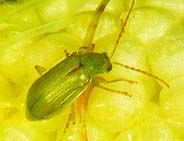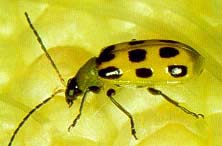Corn Rootworm
Diabrotica spp.
Biology
Western Corn Rootworm, Diabrotica virgifera virgifera LeConte
Western corn rootworm (WCR) adults are approximately ¼ inch long and
yellow with three black stripes on forewings (elytra). The stripes on
female wing covers are distinct, with one on the outside of each wing
cover and the third one along the middle, where the wing covers meet.
The stripes on male wing covers tend to merge across the wing covers.
The white, football-shaped eggs are less than 0.004 inch long. Mature
larvae are approximately ½ inch long, slender, and white with brown head
capsules and a dark plate on the top side of the last segment. Pupae
are white, and their appearance is similar to the adult beetle.

Western Corn Rootworm Adult
Western corn rootworm have one generation per year with larvae present from May through July. Adults are abundant from July through September. A female may lay an average of 500 eggs over several weeks in clutches of about 80 eggs. Most eggs are laid in the upper 6 inches of soil during late summer. During dry years, females will enter cracks in the soil to lay eggs as deep as 10 to 12 inches. Eggs remain dormant until the following spring. Eggs are concentrated near the base of corn and soybean plants, and are spread, both horizontally and vertically, by tillage.

Corn Rootworm Larvae
The larvae hatch in late May or early June and, if corn is present, begin feeding on roots. Larvae complete three developmental stages (instars) as they feed and tunnel in the corn roots. In mid-to late July, pupation occurs and adults emerge a short time later.
When silks in fields begin to senesce, adults will disperse to neighboring, later planted, cornfields or feed on pollen from soybeans, alfalfa, and several species of weeds. The life cycle is completed when adults mate and females lay eggs during August and September. A strain of Western corn rootworm found in east-central Illinois will lay eggs in both corn and soybean fields. As a result of this behavioral shift of the WCR, extension entomologists recommend monitoring soybean fields according to the procedures outlined in: Western Corn Rootworm Insect Information Sheet (No. 1) Because WCR still inhabit and lay eggs in corn, growers also should follow recommendations for monitoring corn fields where corn will be planted again the following year.

Northern Corn Rootworm Adult
Northern Corn Rootworm, Diabrotica barberi Smith and Lawerence
Northern corn rootworm (NCR) adults are approximately ¼ inch long, with
females usually larger than males. Their color varies with age and
among individuals. Both sexes of newly emerged adults are cream to light
brown and become yellowish to pale green over time. Eggs, larvae, and
pupae of the WCR are similar in appearance to the same stages of Western
corn rootworm. The life cycle of the Northern corn rootworm is similar
to the Western corn rootworm except this species has not been shown to
lay eggs in soybean fields.

Southern Corn Rootworm Adult
Southern Corn Rootworm, Diabrotica undecimpunctata howardi Barber
Southern corn rootworm (SCR) adults are approximately 3/8 inch long and
yellow to green with eleven black spots on the forewings (elytra).
Eggs, larvae, and pupae of the SCR are similar in appearance to the same
stages of NCR and WCR. This species overwinters as an adult, instead of
in the egg stage, like WCR and NCR. However, adult SCR do not
overwinter successfully in Illinois. Populations of SCR migrate from
southern states beginning in April. Root and foliage feeding by the SCR
is seldom a problem in Illinois
Injury
Larval feeding on corn roots may reduce
yields. Injured root tips feature brown lesions. In some fields, entire
nodes of roots may be pruned severely. Pruned roots are less capable of
supplying water and nutrients to the growing ears and moderate to severe
root pruning may result in lodging and significant losses at harvest.
Larval injury also may make roots more susceptiable to root and stalk
rot fungi. High adult densities may clip silks resulting in poor
pollination and reduced kernel set.
Monitoring Corn Fields for WCR and NCR Beetles
Growers are encouraged to monitor cornfields for WCR and NCR adults to
determine the need for a soil insecticide the following year if corn
will be planted again in the field. Extension entomologists recommend
the following procedure for monitoring WCR and NCR beetles.
- Scout every week from mid-July through early September in cornfields that may be planted in corn again next year.
- Count all WCR and NCR beetles on two plants in 25 widely separated locations in each field (total of 50 plants). The distance between each plant sampled must be great enough to prevent disturbing beetles on other plants that will be examined. Avoid border rows. Scouting a 40-acre field will take about 45 minutes.
- Approach plants quietly to prevent disturbing beetles to ensure more accurate counts. All beetles found on a plant should be counted, including any located on the ear tip, tassel, leaf surfaces, and behind the leaf axils. Record the number of beetles per plant.
- Divide the total number of beetles per field by 50 to calculate beetles per plant. If the average number of beetles for any week during the monitoring period meets or exceeds recommended thresholds (see table below), growers should consider applying a soil insecticide or rotating to a non-corn crop in that field.
Table 1. Thresholds for Corn Rootworm Beetles for Different Plant Density and Cropping Sequences |
||
| Average number of plants per acre |
Average number of beetles per plant - continuous corn | Average number of beetles per plant - first-year corn |
| 14,000 | 1.4 | 1.0 |
| 16,000 | 1.3 | 0.9 |
| 18,000 | 1.1 | 0.8 |
| 20,000 | 1.0 | 0.7 |
| 22,000 | 0.9 | 0.6 |
| 24,000 | 0.8 | 0.6 |
| 26,000 | 0.8 | 0.5 |
| 28,000 | 0.7 | 0.5 |